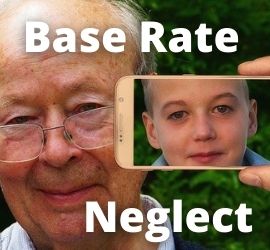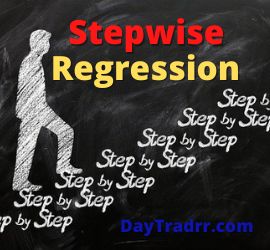What is Base Rate Neglect?
 Base rate neglect refers to a tendency to rely more on specific information than actual probability and statistics when making judgments.
Base rate neglect refers to a tendency to rely more on specific information than actual probability and statistics when making judgments.
Base rate neglect is an error in reasoning. Too little weight is placed on the base rate possibility or actual probability of an event occurring. In behavioral finance, base rate fallacy is when investors erroneously judge the likelihood of a situation by not taking into account all relevant data. Instead, investors might focus more heavily on new “inside” information without acknowledging how this impacts original assumptions. Many instances exist in which emotion and psychology heavily influence investor decisions. As a result, it causes people to behave in unpredictable ways.
In other words, it causes individuals to ignore actual probabilities and statistical information in favor of using irrelevant information. Often, incorrectly believing it to be relevant to make a judgment that ignores the initial probability entirely. This usually stems from the irrational belief that statistics and probability don’t apply for one reason or another when, in fact, they do.
What Causes Base Rate Neglect
There have been a number of explanations proposed for why the base rate neglect occurs. One of the main theories is that it is a matter of relevance. We ignore base rate information when we classify it as irrelevant. Therefore, we feel that it should be ignored. Prior to making a judgment, we categorize the information given to us into different levels of relevance. If something is considered irrelevant or we don’t fully understand it, we discard it. As a result, we do not factor it into the conclusion we draw.
It is not that we are incapable of integrating different types of information. When two different types of information are assigned equal relevance, we will give them equal consideration. However, pushing information off or disregarding it completely is the more common reason we ignore vital information. Also, we often value certain information more than we should. Or, maybe we focus on one source of information when we should be combining it with other sources.
The more specific information is to a situation, the more relevant it appears. Detailed and personal information is, by nature, incredibly specific. As such, we denote it as highly relevant. Base rate information, on the other hand, although specific and precise is very general. As a result, we categorize it as low relevance information. In making a judgment, we take into consideration the information we consider to be relevant. Naturally, we ignore that which has been deemed irrelevant. To many, this may feel like an effective strategy. However, it can actually compromise the accuracy of our judgments.
Base Rate Neglect for Investors
When considering base rate information, two categories exist when determining probability in certain situations.
- General probability – The first is a general probability. What is the likelihood the market as a whole will rise or fall based on current economic trends?
- Event-specific information – For example, how many basis points has the market shifted? What percentage is a company off in its corporate earnings? How many times has a company has changed management.
Investors often tend to give more weight to this event-specific information above the context of the economy as a whole. Oftentimes, they ignore base rates entirely.
Event-specific information is important in the short term, particularly for traders or short-sellers. However, the importance can fade as a factor when attempting to predict the long-term trajectory of a stock. For example, an investor may be trying to determine the probability that a company will outperform its peer group. Hopefully, to emerge as an industry leader. The base of information shows the company’s solid financial position, consistent growth rates, management with proven track records, and an industry with strong demand. All these signals point to its ability to outperform. However, a weak earnings quarter could set investors back, making them think that this is changing the company’s course. As is more often the case, it could simply be a small blip in its overall rise. (Source: investopedia.com)
Base Rate Neglect in Behavioral Finance
Behavioral finance is a relatively new field. It seeks to combine behavioral and cognitive psychological theory with conventional economics and finance. The goal is to provide explanations for why people make irrational financial decisions. According to conventional financial theory, investors, for the most part, are logical, wealth maximizers. However, the base rate fallacy offers an explanation as to why investors overreact to a market event. According to market efficiency, new information should rapidly be assimilated and reflected instantly in a security’s price. The reality, however, tends to contradict this theory. Often, market participants overreact to new information. For example, a change in interest rates can have a greater impact on the price of an asset class or individual security than is warranted. Such price surges are not usually permanent and the effect tends to erode over time. But, these sharp reactions underline how emotional investors’ reactions can be.
Base Rate Neglect Example
For example, consider a specific disease that occurs in 1/1000 patients tested. However, the test has a false positive rate of 5%. But, the test has never been known to fail to detect a person who actually has the disease. What is the chance that a person found to have a positive result actually has the disease? This is assuming you know nothing about the person’s symptoms or signs.
Many would answer as high as 95%, but the correct probability is about 2%. For example, on average, for every 1,000 individuals tested:
- 1 actually has the disease. It is 100% certain that for that person there is a true positive test result. So, there is 1 true positive test result to calculate.
- 999 individuals remain who do not have the disease. However, among those individuals, there are 5% with false-positive test results. As a result, there are 49.95 false-positive test results to consider.
Therefore, the probability that one of the remaining individuals really has the disease is calculated as follows:
- 1 + 49.95 = 50.95 positive test results
- 1/50.95 = 0.019627 (roughly 2%)
- The probability is slightly less than 2 % that one of the remaining individuals who tested positive actually has the disease.
The validity of this result further hinges on the initial assumption that the tests were administered randomly. Not because the individuals were showing other positive symptoms. If that or another non-arbitrary reason for testing the individual was present, then the calculation would have to be adjusted to fairly include the additional information and specific criteria for testing.
How to avoid it
To avoid committing the base rate neglect, we need to pay more attention to the statistical information available to us. Also, recognize that anecdotal evidence and past behaviors are not as reliable predictors of future behavior as we think they are. This requires more effort when assessing the probability that a given event will occur. It’s easy to fall back on automatic, reflex responses. This may make decision-making feel much easier. However, this increases the risk of error. By being aware of this fallacy is half the battle. Then, take an active approach to combat it. Conscious decision-making can help reduce the frequency and the occurrence.
This fallacy can seriously impact financial decisions. Ultimately, it prompts us to overreact to transient changes in our investments. If the base rate statistics show consistent growth, it is likely that any setbacks are only temporary and that things will get back on track. Yet, by ignoring the base rate information, we may feel inclined to sell. Emotionally, see the initial price drop and may predict that the value of our stocks will continue to decline.
 Combat pay or imminent danger pay is a bonus to military personnel in addition to their regular military salary when they are deployed to a combat zone.
Combat pay or imminent danger pay is a bonus to military personnel in addition to their regular military salary when they are deployed to a combat zone.
It is a tax-exempt monthly stipend. The bonus is paid to active members of the U.S. armed services when they are serving in designated hazardous zones and is paid in addition to the person’s base salary. The hazard bonus is not open only to combat soldiers. Any person enrolled in a branch of the U.S. military who is assigned to a designated hazardous area is eligible to receive additional combat pay. Spending as little as one hour on duty in a hazardous zone can qualify for an entire month’s bonus.
The extra bonus may be categorized as hostile fire and imminent danger pay and can be prorated for partial months. You can not receive both hostile fire and imminent danger pay at the same time.
 Base rate neglect refers to a tendency to rely more on specific information than actual probability and statistics when making judgments.
Base rate neglect refers to a tendency to rely more on specific information than actual probability and statistics when making judgments. Combat pay or imminent danger pay is a bonus to military personnel in addition to their regular military salary when they are deployed to a combat zone.
Combat pay or imminent danger pay is a bonus to military personnel in addition to their regular military salary when they are deployed to a combat zone.



